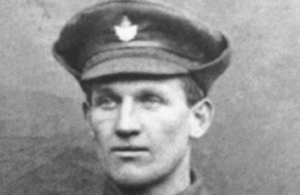WW1 Canadian VC recipient Ellis Wellwood Sifton
The story of Canadian First World War Victoria Cross recipient Ellis Wellwood Sifton.

Ellis Wellwood Sifton [Credit: National Defence Canada]
70 men from Canada received the Victoria Cross, Britain’s highest award for gallantry, during the First World War. As part of the Centenary Commemorations the people of the United Kingdom marked their gratitude to those courageous men by presenting a bronze memorial plaque to their home country engraved with their names. The plaque is now displayed at the British High Commission Ottawa. This archive tells their stories.
Name: Ellis Wellwood Sifton
DOB: 12 October 1891
Place of Birth: Wallacetown, Canada
Date of Action: 9 April 1917
Place of Action: Vimy Ridge, France
Rank: Lance-Sergeant
Regiment: 18th Infantry Battalion, Canada Expeditionary Force
Ellis Wellwood Sifton was born In Wallacetown, Canada, on 12 October 1881. He was working as a farmer when he enlisted in 1914. Before the action that led to his award he was serving as a battalion driver, but asked to leave this role to “take a chance with the boys on the front line”.
Lance-Sergeant Sifton was posthumously awarded the Victoria Cross for his actions on 9 April 1917 at Vimy Ridge, where the 18th Infantry Battalion was part of the successful Canadian attack on German positions. His citation reads:
For most conspicuous bravery and devotion to duty. During the attack in enemy trenches Sjt. Sifton’s company was held up by machine gun fire which inflicted many casualties. Having located the gun he charged it single-handed, killing all the crew. A small enemy party advanced down the trench, but he succeeded in keeping these off till our men had gained the position. He was killed just as he returned with the second man.In carrying out this gallant act he was killed, but his conspicuous valour undoubtedly saved many lives and contributed largely to the success of the operation.
Lance-Sergeant Sifton is buried in Lichfield Crater Cemetery, behind the village of Neuville St Vaast, close to where he fell. There is a plaque in his memory at Tyrconnell, Ontario.